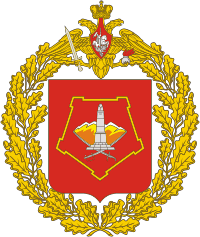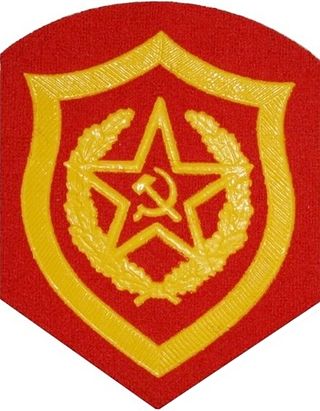Cold War
After the end of World War II, the 7th Guards Brandenburg Order of Lenin Red Banner Order of Suvorov Cavalry Corps was withdrawn to Nakhchivan. In January 1946, the corps was converted into the 31st Guards Mechanized Division. The 14th and 16th Guards Cavalry Divisions were reduced to the 98th and 99th Guards Mechanized Regiments, respectively. A third mechanized regiment, the 100th Guards, was formed from the 14th Division's 56th Guards Cavalry Regiment. The 131st Guards Tank Regiment was formed from the 16th Division's 58th Guards Cavalry Regiment and the 32nd and 114th Tank Regiments; the latter were the tank regiments of the 16th and 14th Divisions, respectively. In the spring of that year the 31st Guards became part of the 4th Army. On 25 June 1957 the division became the 25th Guards Motor Rifle Division at Shamkir. The 98th Guards became the 366th Guards Motor Rifle Regiment, the 99th Guards the 368th Guards, and the 100th Guards the 370th Guards. On 17 November 1964 it was renumbered as the 23rd Guards Motor Rifle Division.
By the late 1980s, the 23rd Guards was garrisoned in Kirovabad (renamed Ganja in 1989) in the Shahumyan region. In 1988 it included the 366th Guards Motor Rifle Regiment (MRR) (equipped with BMPs) based at Stepanakert, [8] the 368th and 370th Guards MRRs, equipped with BTRs, the 131st Guards Tank Regiment, 1071st Artillery Regiment, and 1057th Anti-Aircraft Rocket Regiment. The division's regimental artillery battalions were equipped with towed D-30 artillery pieces. [9] All units except the 366th Regiment were based at Kirovabad.
Elements of the division took part in Operation Ring in May 1991. During the operation the division's commander was Colonel Budeykin. [9] Immediately following this, the larger scope of combat engagements in the area of Stepanakert took place, including the use of BM-21 "Grad" artillery and Mil Mi-24 assault helicopters through to February 1992.
The division, along with the other three divisions of the 4th Army, was ordered to be withdrawn amidst the fighting in the First Nagorno-Karabakh War in May and June. Elements of the 366th MRR appear to have been involved in the Khojaly massacre of February 1992. The regiment was under the command of Colonel Yuri Zarvigorov. [10] However, on June 21, 1992, the divisional column was prevented from departing Ganja by the civilian Azerbaijani population. The Azerbaijanis demanded that the division surrender its military equipment during Azeri declaration of independence, and the division commander, General Major Yury Pokhamov, complied to avoid civilian casualties. This was largely due to a lack of direction and indecision at Headquarters Transcaucasian Military District and at the General Staff. This did not occur because for the most part the officers of the 366th Motor Rifle Regiment had begun to offer assistance to the Armenian population, while the units based in Ganja deciding to side with the Azeri population. This was largely due to about 50 of the remaining 350 personnel of the 366th Motor Rifle Regiment being Armenian, including the commander of the 2nd Battalion, Major Seyran Ohanyan. [11] Of particular use to the Armenians was the regimental tank company's ten tanks.
The division was disbanded in July 1992, after having been forced to hand over most of its weapons to Azerbaijan. Its traditions, honors and awards were transferred to the 13th Motor Rifle Division. [12]
The 4th Army was a Soviet field army of World War II that served on the Eastern front of World War II and in the Caucasus during the Cold War. It was disbanded after the fall of the Soviet Union, with its divisions being withdrawn to Russia and disbanded.

The Azerbaijani Land Forces are the land force component of the Azerbaijani Armed Forces. Since the fall of the Soviet Union, Azerbaijan has been trying to create professional, well trained, and mobile armed forces. Based on 2013 statistics, the country has about 56,850 ground force troops, with additional paramilitary forces of 15,000. In addition, there are 300,000 former service personnel who have had military service in the last fifteen years.
A mechanised corps was a Soviet armoured formation used prior to the beginning of World War II and reintroduced during the war, in 1942.

The Volga–Ural Military District was a military district of the Russian Ground Forces, formed on 1 September 2001 by the amalgamation of the Volga Military District and the Ural Military District. The headquarters of the Ural Military District, located at Yekaterinburg became the new headquarters of the merged district. In 2010 the District was merged with part of the Siberian Military District to form the new Central Military District.

The Red BannerCarpathian Military District was a military district of the Soviet Armed Forces during the Cold War and subsequently of the Armed Forces of Ukraine during the early Post-Soviet period.

The Central Group of Forces was a formation of the Soviet Armed Forces used to incorporate Soviet troops in Central Europe on two occasions: in Austria and Hungary from 1945 to 1955 and troops stationed in Czechoslovakia after the Prague Spring of 1968.

The Transcaucasian Military District, a military district of the Soviet Armed Forces, traces its history to May 1921 and the incorporation of Armenia, Azerbaijan, and Georgia into the Soviet Union. It was disbanded by being redesignated as a Group of Forces in the early 1990s after the Soviet Union collapse. The military district formed as a basis of the modern day armed forces of Armenia, Azerbaijan, and Georgia as well as unrecognized polities of Abkhazia, the Republic of Artsakh and South Ossetia.

The 97th Guards Mechanized Brigade was a rifle, and then a motor-rifle division of the Soviet Union's Army, before becoming a mechanized brigade of the Ukrainian Ground Forces, based in Slavuta in western Ukraine.
The 266th Rifle Division was a rifle division of the Soviet Red Army during World War II. The 266th was formed three times during the war.
The 40th Guards Rifle Division was one of a series of ten Guards rifle divisions of the Red Army formed from airborne troops in the spring and summer of 1942 in preparation for, or in response to, the German summer offensive. It fought in the Stalingrad area during that battle, eventually in the operations that encircled German 6th Army, and then continued to serve in the several campaigns in the south sector of the front, helping to liberate Ukraine and the Balkans, and ending the war at Vienna.
The 7th Guards Cavalry Corps of the Soviet Union's Red Army was a cavalry corps active during the Second World War. It was formed from the 8th Cavalry Corps in February 1943.
The 9th Guards Motor Rifle Division was a Soviet Army unit initially formed as a tank corps in April 1942. In the same year, it was then formed as a mechanized corps in November 1942. This unit then became a Guards mechanized corps in September 1944. Following World War II, the corps were reorganized as a mechanized division in 1945 and then a motor rifle division in 1957 before being disbanded in 1958.
The 213th Motor Rifle Division was a motorized infantry division of the Soviet Army. The division was based in Totskoye and existed from 1968 to 1991. In 1991, the division merged with the 27th Guards Motor Rifle Division.

The Training Center for Junior Specialists of the Kazakh Ground Forces named after Karasai Batyr is a Ground Forces formation of the Armed Forces of the Republic of Kazakhstan.
The 4th Guards Motor Rifle Division was a motorized infantry division of the Soviet Army during the Cold War.
The 47th Guards Nizhnedneprovskaya Red Banner Order of Bogdan Khmelnitsky Tank Division, is a tank division of the Russian Ground Forces.

The 366th Guards Motor Rifle Regiment was a motor rifle unit of the Soviet Army and the United Armed Forces of the Commonwealth of Independent States.
The 8th S. I. Morozov Guards Rovno Red Banner Order of Suvorov Cavalry Division was a cavalry division of the Red Army during World War II. Postwar, it was stationed in Ukraine as the 10th Guards Mechanized Division, which was reorganized as the 83rd Guards Motor Rifle Division in 1957 before being disbanded in 1959.
This page is based on this
Wikipedia article Text is available under the
CC BY-SA 4.0 license; additional terms may apply.
Images, videos and audio are available under their respective licenses.







